After 17 stages and more than 2,000 kilometers of racing, the Giro d’Italia remains insanely close.
The top-three in the GC are separated by less than one minute, and there are still six riders within five minutes of the overall lead. Not far off the podium, Derek Gee is sitting in fourth place, 1:57 behind the maglia rosa Isaac del Toro.
Gee had one of the best climbing performances of his career yesterday on stage 16, finishing in fifth after pushing a Normalized Power of 348w for five hours and 40 minutes.
This stage put multiple GC contenders out of the contention, and cut over a minute out of race leader Del Toro, setting up an exciting final week in the Giro.
In this article, we will dive deep into Gee’s power file, which is one of the most impressive we’ve seen in cycling this year. We are talking about multiple 15-minute blocks over 440w. Let’s take a closer look:
Wet and wild start
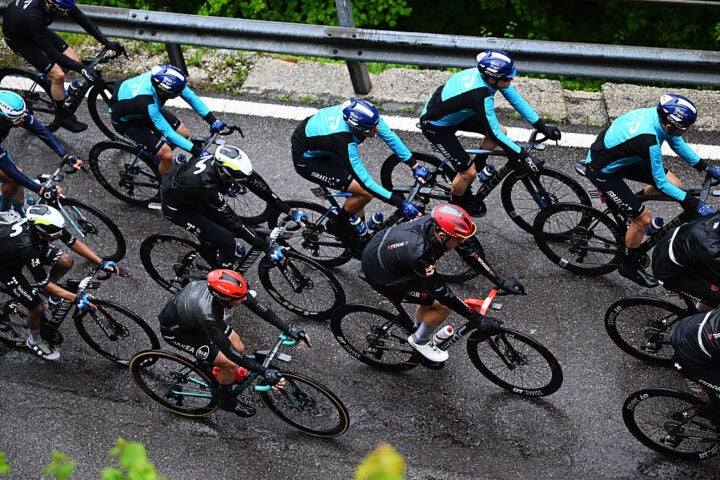
The best Giro stage in years began in typical Giro fashion: cold, wet, and chaotic, with multiple crashes taking out major GC contenders. Primož Roglič had been on the ropes in stage 15, but he was knocked out of the Giro for good after a crash early in stage 16.
The stage profile was a menacing one, with more than 4,700 meters of climbing in 203km, but there was another crucial factor that added to the chaos. While the riders finished under the warm Italian sun, they began in the cold rain in Piazzola sul Brenta.
Neutral zones are typically inconsequential in professional cycling, but this day was different. When the peloton rolled out of Piazzola sul Brenta, it was 65°F and raining. The neutral zone was 7 km long, and Gee averaged 51w with a heart rate of 67 bpm.
That is enough to freeze many riders to their bones, especially if they weren’t fully prepared with wet-weather clothing. As the race began, many riders were on cold legs. Whereas, riders from cold and wet climates might have been thriving – Gee included.
GC Drama on Santa Barbara
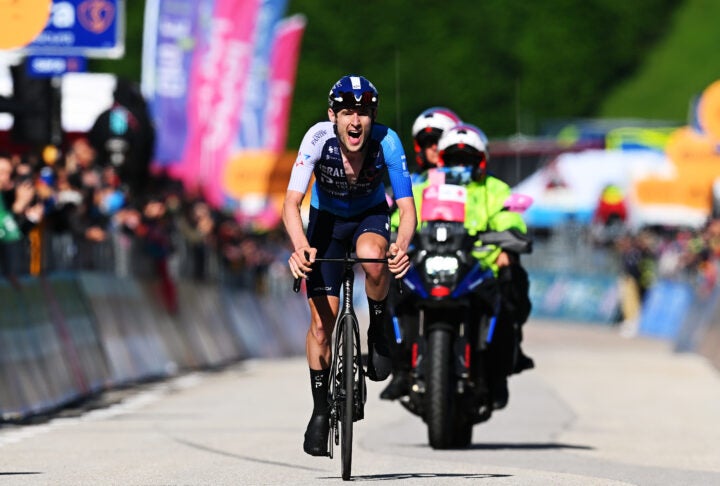
Like any historical Grand Tour stage, the first four hours of the race were simply the appetizer. After a high-speed breakaway formation and two categorized climbs, Gee had already burned over 3,500 kJs before the real race began.
In this first part of the stage, Gee averaged 250w with an NP of 311w. That would be a hard effort for an amateur cyclist, but Gee was able to do this at an average heart rate of 128 bpm. This suggests that Gee was riding in Zones 1-2 for the majority of the race, only dipping into Zones 3-4 on the steep climbs. While the first two weeks of the Giro rewarded aggression and peak power output, this tough final week has rewarded the riders with a high resistance to fatigue.
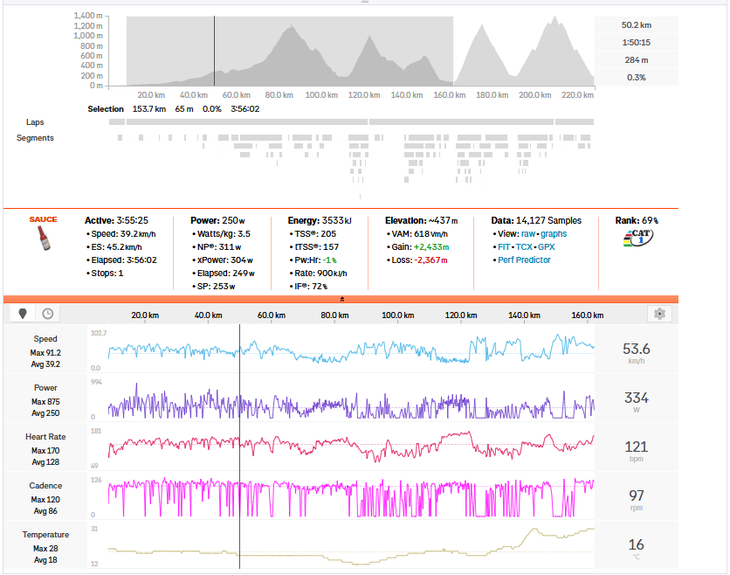
Gee – First 4 Hours of Stage 16
Time: 3:55:25
Average Power: 250w (3.6w/kg)
Normalized Power: 311w (4.5w/kg)
The best stage of the Giro d’Italia truly began on the Santa Barbara (12.6 km at 8.3%) climb with 49 km to go. UAE Team Emirates-XRG seemed to have control of the race, as it was Rafał Majka doing the majority of the pacing. But then it was EF Education-EasyPost who took over, upping the pace for Richard Carapaz.
The first GC casualty was Juan Ayuso, who cracked on the Santa Barbara and lost 14 minutes by the time he crossed the finish line. Egan Bernal and Thymen Arensman were also struggling, but Del Toro looked solid following the attacks of Carapaz and the second-place rider in GC, Simon Yates.
Gee hid himself very well during this portion of the race, staying in the wheels and following moves without overextending himself. The first half of Santa Barbara was ridden at more than 6.4w/kg, which explains why Ayuso and others couldn’t follow the ridiculous pace.
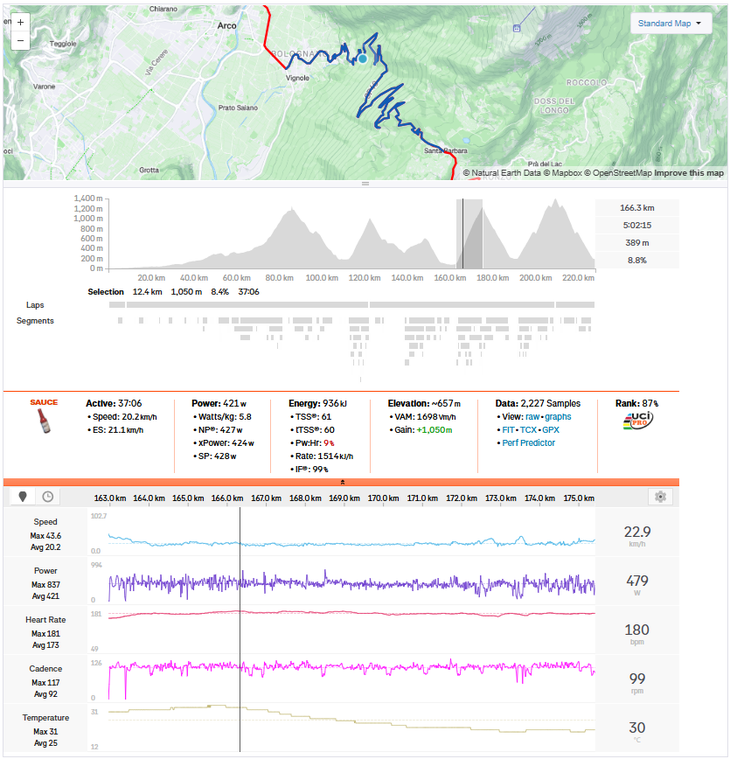
Gee – Santa Barbara
Time: 37:06
Average Power: 421w (6w/kg)
First Half of the Climb (where Ayuso got dropped): 445w (6.4w/kg)
After a 15km descent, the road went uphill again for the final climb of the day: San Valentino. The climb’s statistics are deceiving – 18.1 km at 6.2% doesn’t tell the full story because it includes two short descents. The middle portion of San Valentino is the hardest, averaging 8.8% for 6 km. Any guesses as to where Carapaz, Yates, and Gee would attack?
On the early slopes of San Valentino, you could tell that the GC riders were waiting. Some of them felt great, while others were about to crack. With over 40 minutes of climbing to the finish, there was still a long way to go.
Derek Gee weight is 72 kg (based on PCS). The others average weight from the top 10 is 62,2 kg. Derek Gee is flying in the mountains with 10 kg plus. Exceptional. #Giro
— Jakab Kuczogi (@jakabkuczogi) May 28, 2025
While the GC favorites marked each other, Giulio Pellizzari attacked. Who had once been Roglič’s right-hand man was now a bull let out of its cage. The 21-year-old Italian danced away from the GC group, never to be seen again. We’ll come back to his outrageous power numbers in a minute.
A few kilometers later, Yates attacked with Tel Toro on his wheel. The Mexican maglia rosa was looking good, but then Yates started pulling hard. As the gradient steepened, Del Toro’s shoulders began to rock, and Yates could surely sense that a crack was coming. Gee bridged across to this group, but it wasn’t long before Carapaz launched a vicious attack that no one could follow.
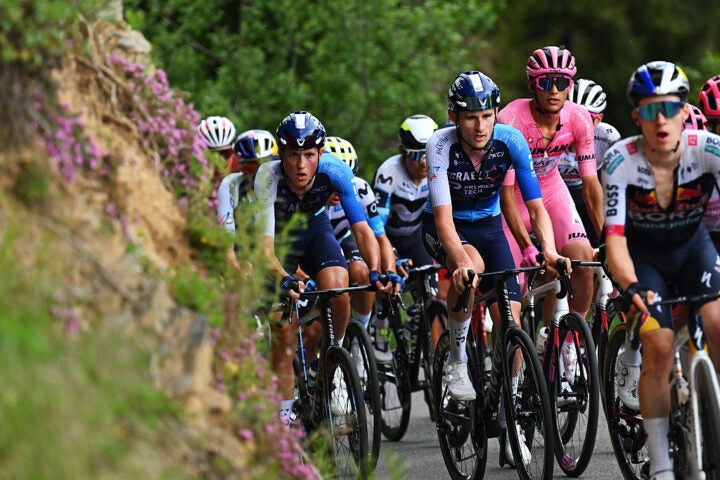
Over the next few kilometers, each group split apart until it was Pellizzari leading Carapaz, then Gee, Yates, and Del Toro with other GC and breakaway riders sprinkled in between. Christian Scaroni and Lorenzo Fortunato took the stage win from the break while Pellizzari rounded out the podium. Carapaz crossed the finish line next, 13 seconds ahead of Gee, who was 29 seconds ahead of Yates.
Del Toro barely held onto the maglia rosa, finishing 13th on the stage, one minute and 36 seconds behind Carapaz. As we dive into the numbers, we can see just how impressive these performances were.
Fatigue resistance is a massive talking point in professional cycling, and for good reason.
Few races are won by fresh, peak power efforts, compared to many more races that are won by strong efforts done after 3,500 kJs. In professional cycling, we are talking about efforts made four to six hours into a race.
When the GC riders began the final climb to San Valentino, Gee had burned 4,600 kJs with an NP of 330w for five hours. Most riders would have been exhausted by this point, but Gee was able to execute one of his best performances of the Giro.
With power numbers like this, it’s incredible to think that Pellizzari and Carapaz went even faster. As for Del Toro showing his first sign of weakness – the Mexican still produced nearly 5.9w/kg for 47 minutes after more than five hours of racing.
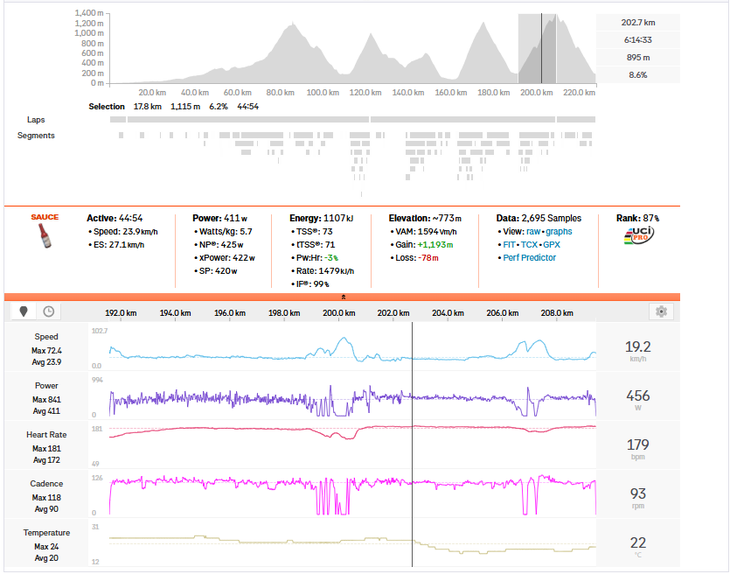
Gee – San Valentino
Time: 44:54
Average Power: 411w (6w/kg)
Middle Section of the Climb: 17 minutes at 448w (6.4w/kg)
Pellizzari: 44:26 at ~6.2w/kg
Carapaz: 44:41 at ~6.1w/kg
Stage 16 turned the GC on its head. In just a few hours, Roglič and Ayuso dropped out of contention, Yates and Carapaz closed to within 31 seconds of the maglia rosa, and Pellizzari showed that he is one of the best climbers in professional cycling.
If it wasn’t for a disastrous stage 1 in Albania, Derek Gee would be 34 seconds from the maglia rosa right now. With two more major mountain stages to come, anything could happen in this year’s Giro.
Power Analysis data courtesy of Strava
Strava sauce extension
Riders:
Derek Gee
